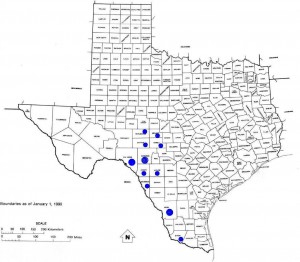How Drought and Wildfire Could Bring Bears Back to Texas

Photo Courtesy of Ray Janiczek.
A Black Bear spotted in Brewster County. Black bears in Texas are generally smaller than in other parts of the country.
There are hardly any bears in Texas, but it hasn’t always been that way. Black bears used to roam the state from the Piney Woods of the east to the mountain ranges of the far west.
Then American colonists arrived.
Bear hunting was “part of the hunting culture that early Texans enjoyed,” Texas Parks and Wildlife Diversity Biologist Jonah Evens told StateImpact Texas. “Eventually we wiped them out completely from the state.”
By the early 1900s there were no bears left. The nearest breeding populations remained across the border in Mexico.
“And then there were no bears in Texas for decades until they returned to Big Bend National Park, I believe it was the early 80s,” Evans said.
That Big Bend population in remained stable, but never expanded to other areas. In East Texas the occasional bear would wander in from Louisiana, but never stuck around to have bear babies. And that’s how things stood until just a couple of years ago.
“In this last two years we’ve had a whole lot of dispersal, a lot of movement into other parts of the state,” Evans Says.
At least 12 sightings were reported to Parks and Wildlife this year alone, with bears reported even in the Texas Hill Country. Scientists believe drought and wildfires in Mexico are driving the creatures back to Texas. And some of them are desperate enough to come closer to human settlements than they normally would in their search for sustenance.
When bears do come close to humans, experts urge tolerance and caution.
“Hopefully you can enjoy the experience of actually seeing a bear but understand that coming into these areas they don’t necessarily want to be by people,” Professor Patricia Moody Harveson, who studies bears at Sull Ross State University, told StateImpact earlier this year. “They’re looking for things because they’re missing things right now.”

Map courtesy of University of Texas at Austin, blue dots added by StateImpact Texas.
The blue dots mark counties were bears aren't usually spotted but were seen in 2012.
“In general they’re kind of like big racoons, we recommend that people shew them away and get back into a safe place if they can,” said Texas Parks and Wildlife’s Evans.
The bears being spotted now, may be the start of a repopulating of the state. We could be watching the slow return home of a species that looked like it may have been gone for good.
“I believe that some of these dispersing bears will find hospitable ranch land in Texas. And they could breed with some other bears out there,” Evans said. “The real telltale would be seeing cubs.”
Texas Parks and Wildlife is asking Texans, especially near the border, to secure their garbage and other food stuff from bears. It also reminds people not to feed bears in the wild.
If you happen to see a black bear. Texas Parks and Wildlife would like to hear from you.
